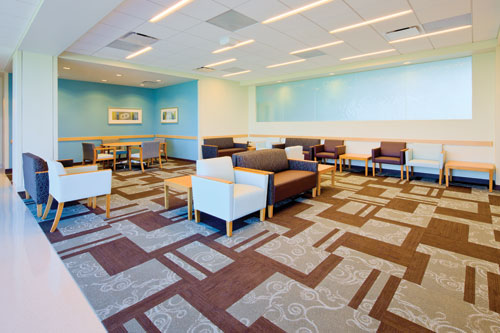Functional Color and Design in Healthcare Environments
Studies show that stable and secure environments in neonatal intensive care units (NICU) help the development of babies. Babies heal faster when they are in close contact with their parents and family members who often choose to stay close around the clock. These rooms may need to include showers, sleep sofas, TV and wireless internet. Colors, natural light, warm decor and original art also contribute to a quiet and healing environment. In general, the atmosphere in both nursery and NICU areas should incorporate neutral colors, warm décor and gentle color accents.
Surgical Areas
Surgical suites in the 1960s and 1970s were designed for the function and the technology of the era. Most surgical rooms had ceramic tile walls and conductive flooring. Today's designers are finding that surgical environments are best when calming and soothing to patients as well as creating a professional and inspirational work atmosphere for staff. Depending on surgery performed, color selections may vary. In general, neutrals, greens, teals and blues are chosen due to their cool and soothing qualities.
Many new surgical suites are offering LED lighting with filters that can change the color of the lighting to one chosen by the patient. Glass panels have been incorporated into rooms to mask equipment, sometimes etched with scenes of nature. The Society of Critical Care Medicine recommends using calming colors that promote rest in critical care units.12 Frank Mahnke, president of the IACC, advocates quiet and relaxing tones with perhaps even a slightly warm color to lift the spirits in recovery rooms of patients who have just undergone surgery. In addition, postsurgical patients recover more quickly, hospital stays are shortened, and costs reduced when patients are exposed to a window view.
Emergency Rooms and Treatment Areas
Barbara Huelat, AAHID, FASID, IIDA, is one of the designers on Project ER One, a federally funded initiative to examine the ideal emergency room in case of mass casualties due to a terrorist attack at the nation's capital. In the design of this prototype, Huelat recommends that emergency environments need to be areas with soft and muted palettes based on nature.13 The focus of good design is to achieve safety, comfort and speed. All materials used in ER rooms should be selected for good acoustic values and the ability to mitigate the spread of bacteria.
Exam and consultation rooms may need to incorporate neutral colors that will not interfere with visual diagnosis. The addition of imagery that conveys a nature theme supports the goal of creating a comforting experience.
Staff Areas
Due to the critical nature of observation, labs are best supported by whites, off-whites, tan, beige or gray tones. It is best to add color only as an accent on furniture, seating and with artwork. Work stations should be visible and use good ergonomic design. Staff lounges can be designed as a respite from the rest of the hospital areas incorporating bright colors, and contemporary artwork.
 |
The waiting area at Banner Ironwood Medical Center, designed in hues of a serene winter palette, includes adjacent ambient light, views and decorative glazing to the patient and staff corridor. Photo by Ross Cooperthwaite |









